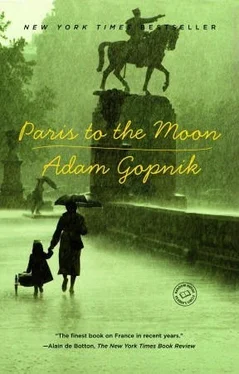In preparation for our own four-night stay we had first to search for the right clinic. Friends recommended two: the Clinique Sainte-Isabelle, in the leafy suburb of Neuilly, and the Clinique Belvedere, in Boulogne-Billancourt. We went to tour them. Both clinics had a pastoral, flower bed, medical but not quite hospital feel, like the sanitarium to which they pack off Nicole in Tender Is the Night. I liked the Belvedere best. The rooms there had a nice faded white and pale blue look, like the room in Madeline where she goes to have her appendix taken out and sees the crack in the ceiling that has a habit of sometimes looking like a rabbit. The cracks in the ceiling at the Belvedere were expressive too, and for a premium you could have a room with French doors leading out onto the garden. (The ordinary rooms were less grand, though they mostly had garden views too.) But what I really liked about the place were the clippings in the formal salon—the waiting room—downstairs, which was filled with dusty silk roses and blue and gold Louis XVI furniture. The clippings chronicled the birth of minor nobility in the halls of the Belvedere. A Bonapartist pretender had been born there, I remember, and also I think a prince of Yugoslavia. I liked the kingly company, particularly since it was such cheesy kingly company.
Martha, though, as we toured the clinics, kept asking gentle, pointed questions about labor relations with the anesthesiologists. Now, the anesthesiologists here—were they unionized? Did they have enough vacation time? Would the clinic manager say that they were happy with their working conditions? How long had it been since they signed a contract? Were there any. well, radicals among them, the kind of ex-Trotskyite soixantehuitards who might suddenly call for mass action by the workers? Eventually, we settled on the Clinique Sainte-Isabelle, which seemed to be the sensible, primly bourgeois choice of all our friends and which had a couple of full-time anesthesiologists on call, neither of whom looked like a sansculotte.
Everything was going along fine, in fact, until our meeting with the sage-femme, the wise woman, or, in American, the midwife. She was in yet another of the suburban clinics, an odd Jacques Tati modern place. This meeting was brisk, and it concentrated on two essential points: breathing and lying. The breathing bit we had heard about before—you are supposed to breathe from the diaphragm—but she emphasized that it was just as important, for a happy birth, to remember never to tell a taxi driver that you are in labor. Whatever you do, she said, don’t say that you’re in labor, or might be in labor, because no taxi driver in Paris will take a pregnant woman to her clinic, for fear other having the baby in his car. (You can’t call an ambulance because an ambulance won’t go over the city line, and our clinic was out in Neuilly.)
Then how were we going to get to the clinic? Martha asked. (We don’t have a car.) It’s no problem, I interrupted, we’ll simply walk over to the taxi stand. (You can’t call a taxi, because there is a stand right across the street from our apartment.)
“I won’t be able to stroll across the street and stand in line if I’m in labor,” she objected. “I’ll wait in the courtyard. Just get him to do the demi-tour.”
At these words my heart was stricken. Demi-tour means literally a U-turn, but in Paris it is also a half-metaphysical possibility that exists on the boulevard Saint-Germain just across the street from our apartment building. The boulevard itself runs one-way, from east to west. There is, however, a narrow lane carved out on it, for buses and taxis, that runs the other way, toward the place de la Concorde and the quai d’Orsay and, eventually, if you turn right over a bridge, toward Neuilly and the clinic too. Leading off this lane, at a single light about a hundred feet from our building, there is a small, discreet curved arrow marked on the asphalt. This arrow means that a taxicab—and only a taxicab—can make a U-turn there and go the other way, with the rest of the traffic. In principle, I could get a cab going against the traffic, have him do the demi-tour, pick up my pregnant wife, and then go back against the traffic. The trouble is that, though I have sometimes succeeded in persuading taxi drivers, when we arrive from the airport, to make the demi-tour, I have just as often failed. “It’s impossible,” the cabbie will tell you, when you ask him to do it.
“No, there is an arrow printed on the pavement that advertises the possibility of this maneuver,” I will say. (When I’m under stress, my French becomes very abstract.)
“I’ve been driving a taxi for twenty years, and it doesn’t exist,” the cabbie will say. Then you either give up or get hot under the collar, and neither approach helps.
If I asked a Paris cabdriver to attempt the demi-tour at, say, five in the morning, to pick up a very pregnant-looking woman, he would know that the only reason was that she was in labor, and to the insult of being instructed would come the injury of being asked to ruin his cab.
For the next few weeks I became obsessed by the logic and strategies of the demi-tour. What if I couldn’t pull it off? The only thing to do was to rehearse, just as we had done in New York in the Lamaze class. So I began walking over to the taxi station at all hours of the day and night, getting in a cab, asking the driver to make the demi-tour, and then going, well, someplace or other. Then I walked home. Sometimes the driver made the demi-tour, and sometimes he didn’t. I was determined to keep practicing, until it felt as natural as breathing.
We still hadn’t got to the bottom of the whole choix du roi thing. Martha had decided to give in to the obstetrician’s insistence that she start swimming, and one day, with Luke, we got into a cab to go to the pool. The taxi driver was wearing a short-sleeved shirt, and had gray hair and a lot of metal teeth. Suddenly he chuckled and said, of Luke, “Why, he speaks so well. Tell me, is it a little sister or a brother?” A sister, we said, and I grimaced and tightened inside as I prepared myself for the response, which, of course, came on cue. “Ah,” he said, slapping the steering wheel. “ C’est le choix du roi!”
I was so fed up that I said, “Please explain it to me.” It was an ironic, rhetorical question. But he didn’t miss a beat.
“I will be happy to explain it,” he said, and he actually pulled over to the curb, near the Crillon Hotel, so that he could speak in peace. “In Latin countries we have what we call Salic law, which means that only your son can inherit the throne. You Anglo-Saxons, you don’t follow Salic law.” I let the Anglo-Saxon thing go by. “For your Anglo-Saxon royal families, it doesn’t matter if the king has a nana or a mec.” A nana is a doll, and a mec is a guy. “But you see, a French king, under Salic law, had to consolidate his hold on the throne by having a boy. And he had to have a girl, so that she could be offered in marriage to another king, and in this way the royal possessions would be expanded, since the daughter’s son would be a king too. He,” he said, gesturing toward Luke in the backseat, “is your strong piece, to be kept in reserve, while she”—he gestured toward Martha’s belly—“is your pawn to build your empire. That’s why it’s the king’s choice: first a boy to hold the throne, then a girl to get another. Tendresse has nothing to do with it. That is why it is the choix du roi.
“It is very odd,” he went on expansively, “because in the Hundred Years’ War the king of England, as duc de Guyenne, a title he had inherited from his grandfather, was subject to Salic law too. The story of how this worked itself out in the making of the two monarchies is a passionately interesting piece of history. I recommend the series Les Rois Maudits [the damned or cursed kings], which is a fascinating study of this history, particularly of the acts of John the Good and what he did as an act of policy to accommodate the Salic principle. The books are by Maurice Druon, of the Academie Francaise, and I heartily recommend them. Passionately interesting.”
Читать дальше












